One of the first sightseeing missions I embarked on while in Japan in 2005 was to Kamakura, a small, sleepy town to the south of Tokyo. Kamakura has a lot to offer for a day trip: a ton of temples within walking distance of the JR station, hidden restaurants in the downtown area with plenty of charm (we ate amazing wakame udon at a place we literally stumbled into after walking for three hours straight), and if it's summer time, a great beach to while away a day in the sun.
Kamakura is an easy place to get to, a quick one hour train ride from Tokyo Station along the Yokosuka Line. As I usually do on any extended trip minus children, I had my knitting with me, my husband had a book, and we alternately attended to our hobbies while watching the countryside speed by us. We were in Japan over the American Thanksgiving holiday, so no beach time for us, but I remember it being a beautiful sunny day, perfect for walking and sightseeing.
When the first destination is fun but the second is inspiring…
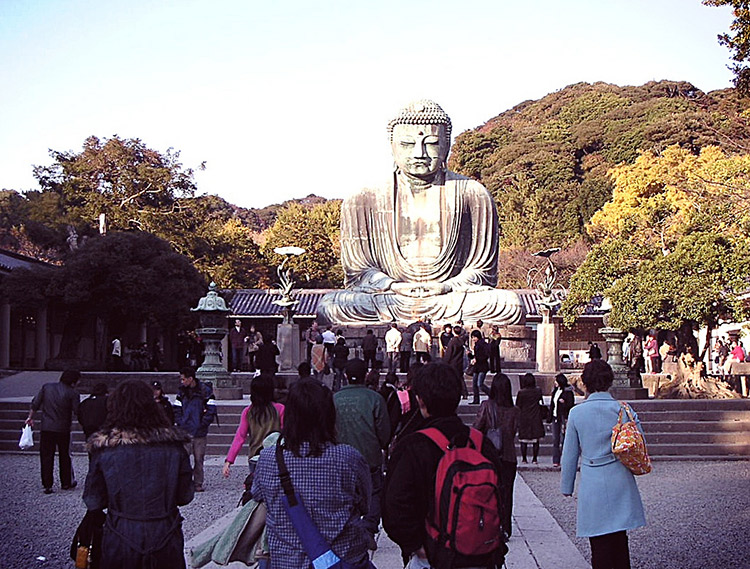
The first stop for most just coming off the train in Kamakura is to walk west along the main road towards the Daibutsu, the large sitting buddha.
It's an extremely popular destination for both foreigners and Japanese alike, so you won't be the only person standing in front of the giant buddha making the peace sign while others snap photos with rapid abandon. Off to the right side of the giant buddha is a covered area with a huge, absolutely gigantic, pair of straw shoes that made my husband and me laugh. I stood and wondered about the person who had woven them hoping buddha would step off his platform and walk away. Then I took a photo. Of course.
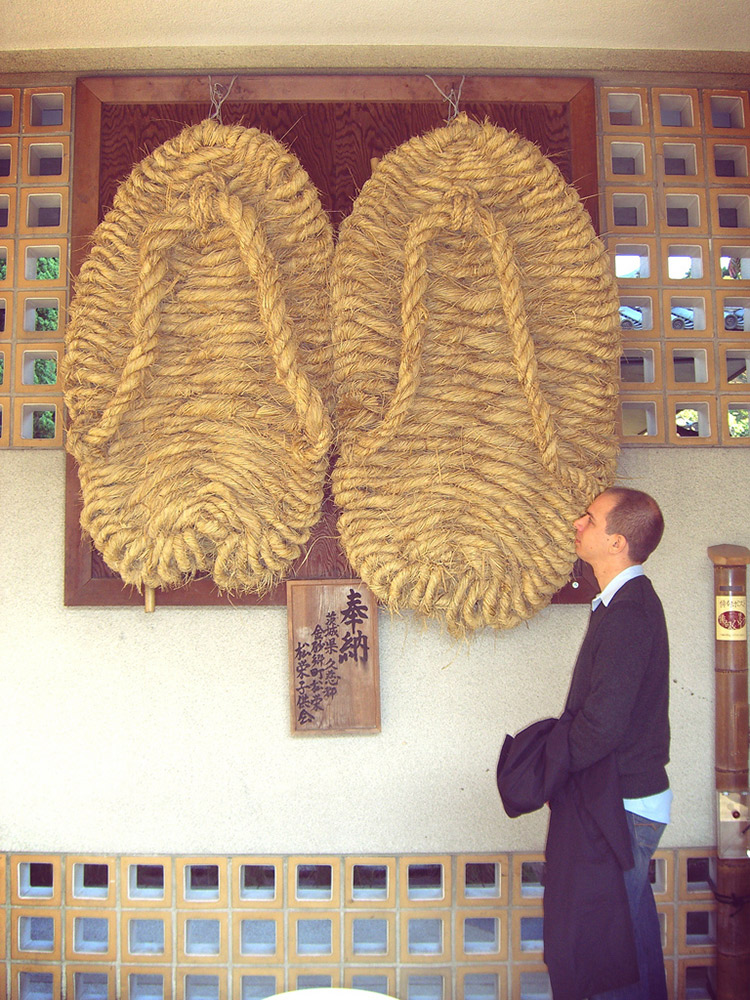
The Daibutsu is fun and interesting, but the statue is, at most, a ten-minute sightseeing effort. Stand and gaze at its immensity, maybe burn some incense, sit and ponder your significance, and move on.
Traveling further east from the daibutsu, we came to the temple I was most interested in, Hasedera. I knew from friends who had visited this temple that it was high up on a hill and had a beautiful view of the bay and beach beyond the city. But what really draws people to Hasedera are the Jizō statues.
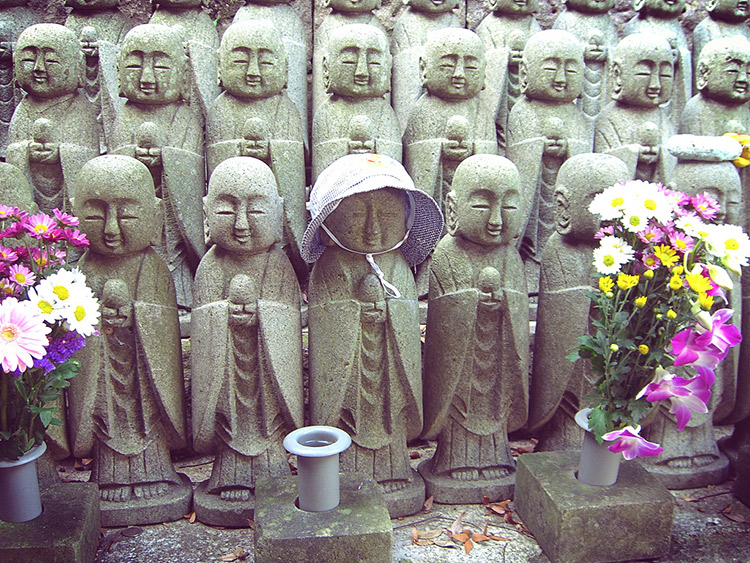
These tiny statues are placed on the temple grounds to honor deceased children, children who have either died young or in childbirth, and there are hundreds of them in perfectly symmetrical lines. What struck me most about spending time with the Jizō statues was how quiet everyone was. Silent and respectful. Each statue was a marvel, a representation of a tiny life lost before he or she could make their mark on the world. I wasn't the only one who kneeled down to make eye contact with one, like you do with a child you want to talk to. I snapped a few photos of them all in a row, and when I placed my camera back in my bag, my knitting was right next to it. I didn't know this tradition of knitting or crocheting hats or scarves for Jizō statues. Just like we keep our kids warm in the winter, these knitted items protect the little statues from rain, wind, snow, and sun. Had I been prepared, I would have knitted a baby hat and brought it along to adorn a lost soul.
Who was Jizō?
Jizō is best known as the protector of deceased children, especially children who have died before their parents or during childbirth. He guards them and escorts these children into the afterlife across the Sanzu River so they won't be forced to make penance for all eternity for not having outlived their parents. But Jizō is also the saint that protects travelers and common people, so his likeness is not just found at temples but also at roadside stands and cemeteries.
There is a Japanese children's story, Kasajizō, about an old man and woman who are poor but still manage to help the animals that depend on them even when they are starving. They're kind and thoughtful people, despite having very little. When the old man is unable to sell hats he and his wife have made in exchange for food, he places the hats on his neighborhood's Jizō statues. In return for his kindness, the Jizō statues come to life and deliver food to the old man and his wife. Continuing the circle of gift-giving, the old man and his wife return what they don't eat to the Jizō statues to thank them.
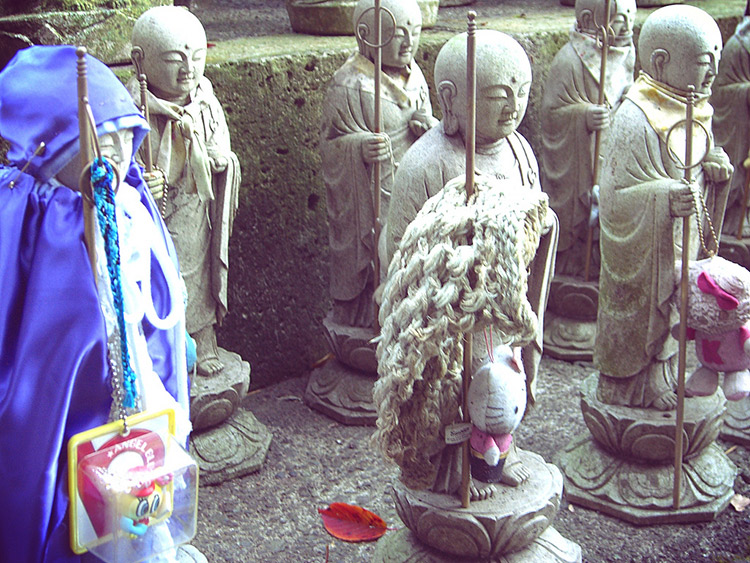
This story is so iconic of Japanese life, especially concerning the circle of gift-giving that can occur with Japanese people. Once someone is presented a gift, they must respectfully gift something back to the original giver at an appropriate time or holiday. It becomes an obligation, one Japanese omiyage shops are more than pleased to help you with should you be traveling and need a gift to bring home to your coworkers or neighbors. Jizō, traveling, and gift-giving all go hand-in-hand. He is a deity you should keep on your side, at all times.
Protect Jizō from the elements with your knitted gift
Jizō is known for being a benevolent god, helpful and kind, so it shouldn't come as a surprise that he deserves a lot of love and affection. Hats and scarves are common gifts amongst the statues, but if you look closer you may find other gifts: a toy yo-yo, a mobile phone charm, a Hello Kitty stuffed animal, a pot of flowers, or even jewelry. Gifts arrive for Jizō statues almost daily, piling up next to and between them until someone comes and moves them to add more.
If you're a knitter like me, now would be a good time to think about providing him with something warm to get him through winter. I'm sure many of us would want to shroud Jizō in the finest wool and cashmere, but let's think practically for a moment.
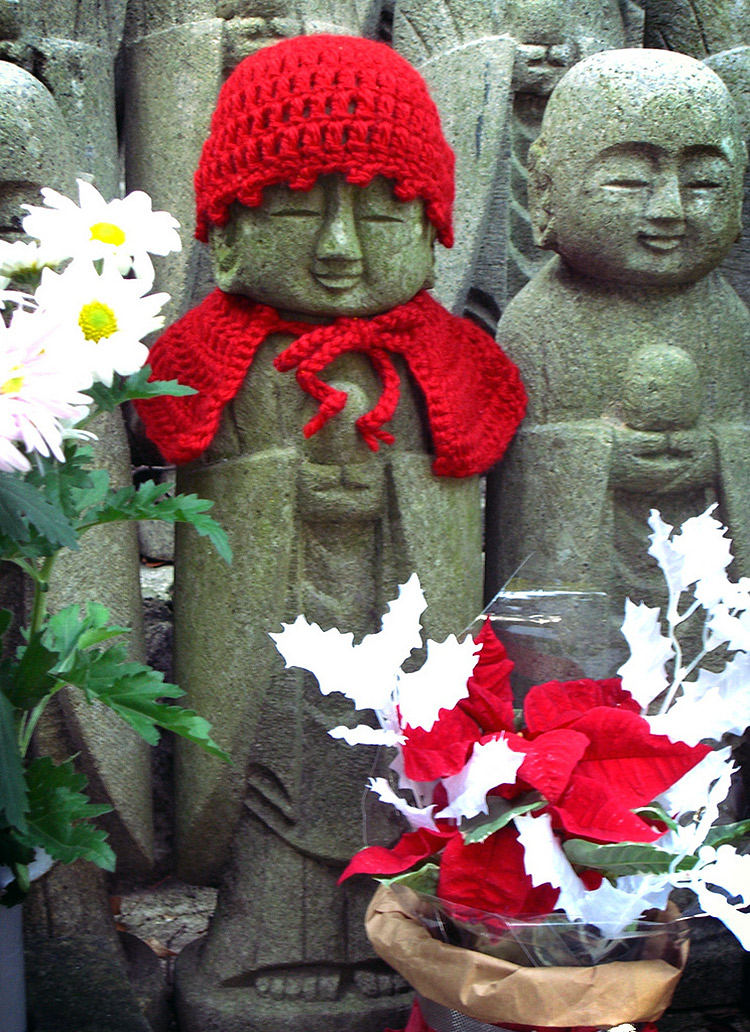
You want your gift to last for a long time. If you're in Japan for a short stay, it would be worth it to knit something to last until the next time you visit Japan, if ever. You need a shield for your statue, not a comfortable and fluffy sweet frock.
Need to learn how to knit first?
Knitting has become extremely popular in the last five years with well-known figures such as Margaret Atwood, Julia Roberts, Christina Hendricks, Kate Middleton, and even Ryan Gosling all publicly talking about their knitting. Knittinghelp is my favorite online resource for learning to knit. Their videos are clear and easy to understand. If you learn better one-on-one with a teacher, be sure to check out your local yarn store to see if they have classes. Once you've purchased needles and yarn, become a member of Ravelry (it's free) and log all of your projects there, find others who knit in your community, and cruise the Ravelry boards for inspiration.
Knitting For Jizo

Knitting for Jizō presents its own set of challenges. The statues live outdoors all year round and the weather in Japan can range from blistering hot to frigid to typhoon winds that blow houses down. My suggestion is to go with acrylic yarn, the more workhorse yarn the better. Crocheted red hats are a popular choice (as evidenced by the photo above) because red is the color of life and has traditionally been associated with the protection of children in Japan. It is not uncommon to find Jizō dressed in other colors, though, so I challenge you to step outside the norms and knit or crochet something with love from your heart. Choose a color or pattern that means something to you, something you'll be able to pick out of the crowd because, if you're lucky, you may see your gift again in photos online!
When choosing a size, the smaller the better. Jizō statues are generally small with preemie-sized heads. Knit the newborn size but don't go larger. If you have the skills, add a tie to keep it attached to the statue's head during typhoons. I have a few pattern suggestions too, if you need somewhere to start.
- The Basic Newborn Hat by Major Knitter
- Here's an example of it knitted in stripes
- If you're a crocheter, try the Teresa's 10 Minute Crochet Preemie Hat
- Here's an example of them crocheted in several colors
- And here are some more in muted colors with stripes
Remember, you're crafting this for a statue! You don't need to worry about how scratchy it'll be or if you screwed up your decreases. If you have time, knit or crochet a thin, long scarf to add as well. And though you probably don't want to get too involved with this, the crazier the design and color choice, the better. Have you seen Japanese street fashion? It's out there, way out there. Your Jizō attire will attract more photos and additional gifts should you decide to be creative so shower your chosen statue in the something you had fun making, something that will bring a smile to mourners' faces, or just be a bright spot in an otherwise somber tradition.
